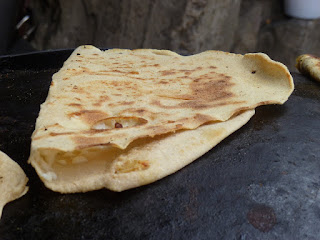I’m not quite sure if I’d say that the modern US has its own street food culture beyond the hot dog cart, but we’ve been a fertile ground for street foods from around the world to find a place in our national appetite. You can probably find some version of tacos, fish and chips, gyros, or falafel in just about every city, in old-school street carts and diners, in massive corporate fast-food chains, in hipster food trucks. But it’s amazing to see the spread of certain kinds of food cultures. For years, the only type of ramen that most of us ever encountered was that styrofoam cup of noodles and dehydrated vegetables. When I was growing up, nobody around me really knew what shawarma was, but since the Avengers made a feast of it, it has definitely arrived.
So let’s start with shawarma. Somehow I had shawarma only once on this trip. That was definitely not enough.
It starts with the meat. Thin slices of marinated lamb are stacked on a vertical spit and roasted for hours.

 |
| Like much street food, shawarma goes well with beer. |
There’s also a version with roast chicken and lashings of toum, which literally just means “garlic.” It’s a creamy garlic sauce made of garlic, oil, salt, and sometimes a bit of lemon juice. You puree the garlic with the oil so that it emulsifies; it has a texture similar to mayonnaise but infinitely more potent and delicious. The chicken shawarma also frequently includes french fries, as this one does. (I don't think I've mentioned this yet, but French-fried potatoes are ubiquitous on Lebanese menus, whether in restaurants or in home kitchens.)
Fries in sandwiches are the greatest thing ever and if you’ve never tried it, you really should. One of the best sandwiches I’ve ever eaten was a shawarma-style wrap with fried eggplant and french fries and garlic sauce. Or a Lebanese-style hamburger: you can either use a plain beef patty or kafta (ground beef or lamb seasoned with parsley and minced onions), but pile some garlicky cabbage slaw and a handful of fries on top before you cap it off with the bun, and you will not be sorry. (My dressing for Lebanese-style coleslaw is olive oil, lemon juice, fresh garlic, salt & pepper, and just enough mayonnaise to make it creamy; for a small head of cabbage, maybe a tablespoon at most.)
You can make a pretty good approximation of shawarma in your home kitchen, even lacking one of those cool spit-roasting contraptions. You can marinate thinly sliced steak in the appropriate seasonings, panfry it, and serve it with all the garnishes to make your own sandwiches. It’s actually pretty easy to do if you’re cooking for a crowd, and you can even use bite-size pita pockets to make little shawarma sliders.
 |
| Pan-roasted beef with shawarma seasonings. |
 |
| Parsley and onions with sumac; cucumber pickles; tahini sauce; pickled turnips and hot peppers in center. (The turnips get their vibrant color because they are pickled with beets.) |
The kebab has a long and venerable street-food history, too, and has moved indoors to places like this one, across the street from a busy college campus, where you can choose your own kebab. Sandwich to go? Plate with rice and salad to stay? Endless possibilities!
And let’s not forget that other great sandwich creation: falafel. You can find falafel on just about every street corner in every city, but my cousin took us to the one that he claimed was the best in town.
Falafel begins with whole dried fava beans and chickpeas, which are soaked for at least twenty-four hours, but not cooked. The rehydrated beans are ground and mixed with spices. The resulting dough looks like this:
A lot of places pre-cook the falafel and then reheat it for sandwiches, but this joint cooks all of its falafel fresh to order. It comes straight out of the fryer into your sandwich. Add parsley, tomatoes, pickles, and plenty of tahini sauce. If you like it spicy, you can request it with hot chili sauce.
This other place dipped the cooked falafel in sesame seeds. Yum!

Remember how I said manaeesh wasn’t just for breakfast? We enjoyed it as a midday snack when we found a vendor making and selling some in a town square.
 |
| This was her whole operation: a gas oven outside a little nook with one work table. |
 |
| Stretching like pizza dough! |
The manaeesh that have toppings get them before they go on the oven:
 |
| Zaatar |
 |
| Cheese |
 |
| No plates or utensils needed. |
And then there was this guy, selling nuts, fruits, and sweets out of the back of his car. I’m not sure you can get any more street food than that.
















No comments:
Post a Comment